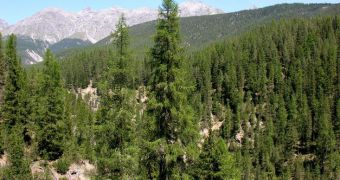Our planet's atmosphere is a delicate mix of various chemical compounds, that cycle through the Earth continuously. Understanding how these cycles work is essential to making sense of how the planet works as a whole, and Earth-sensing satellites of the European Space Agency are making this easier.
Recently, investigators have focused their efforts on the boreal forests of Eurasia, which represent the largest land-based ecosystem of this type in the entire world. The experts wanted to learn how they influence the chemical composition of the atmosphere.
The global climate system is also heavily influenced by these forests, but thus far researchers had little clues as to the extent of these influences. ESA satellites helped shed some light on this mystery.
Earth observation data were collected through the Atmosphere-Land Interaction Study (ALANIS) initiative. The info referred to the way boreal forests contribute to influencing greenhouse gas and aerosol concentration in the atmosphere.
The processes governing the interactions between land and air were also scrutinized in detail. Very few studies sought to quantify, model and understand the processes taking place in this vast ecosystem.
A collaboration between the ESA Support to Science Element and the International Land Ecosystem-Atmosphere Processes Study (iLEAPS) of the International Geosphere-Biosphere Program made ALANIS possible, SpaceRef reports.
“This collaboration draws together Earth system and Earth observation communities and is vital for planning future remote-sensing products to increase our understanding of land-atmosphere interactions,” says iLEAPS International Project Office executive director Anni Reissell.
There are currently three main directions of research in the project, corresponding to the most important factors influencing the atmosphere. These are methane, smoke plumes and aerosol production, experts say.
“I am really excited by this project. It addresses a key issue in the global methane cycle and is developing new products to test and improve one of the leading land surface models,” says UK Center for Ecology and Hydrology expert Garry Hayman.
“A better knowledge of plume injection height is important because pollutants reaching above the planetary boundary layer are transported thousands of kilometers,” adds University College London (UCL) scientist Jan-Peter Muller.
The first ALANIS results were already presented this November, at the EO for Land-Atmosphere Interactions Science Conference.

 14 DAY TRIAL //
14 DAY TRIAL //